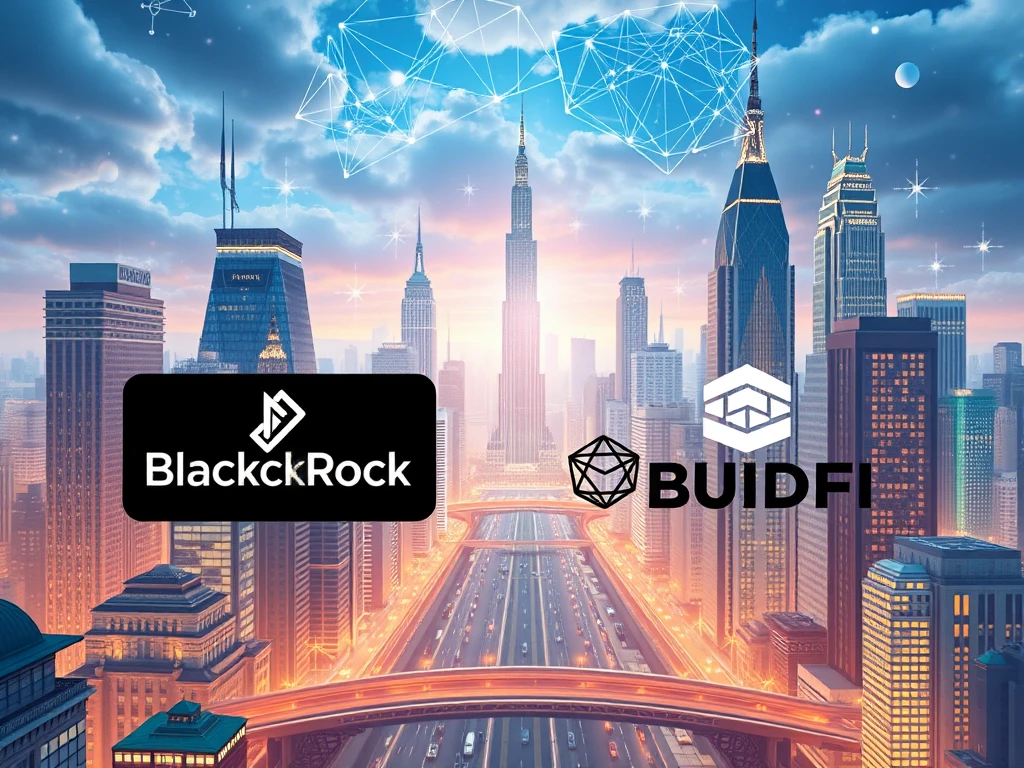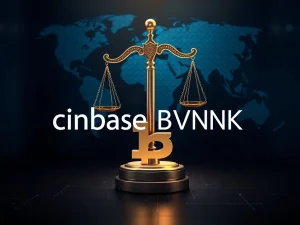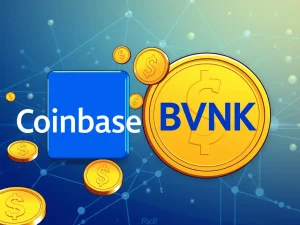Explosive Growth: BlackRock BUIDL Fund Revolutionizes Crypto and TradFi

The financial world is witnessing a fascinating convergence as traditional finance (TradFi) and cryptocurrency realms intertwine. Leading this charge is none other than BlackRock, the world’s largest asset manager, with its groundbreaking BlackRock BUIDL fund. But what exactly is BUIDL, and why is it sending ripples through both crypto and TradFi sectors? Let’s dive deep into this game-changing innovation.
Decoding BlackRock’s BUIDL Fund: A Tokenized Money Market Revolution
BlackRock’s BUIDL fund, officially named the BlackRock USD Institutional Digital Liquidity Fund, is a pioneering step into the world of tokenized assets. Imagine traditional financial instruments, like money market funds, being traded as cryptographic tokens on blockchains – that’s precisely what BUIDL achieves.
To understand BUIDL, let’s break down the basics:
- Money Market Fund Explained: Think of it as a safe haven for your cash. Money market funds invest in highly liquid, short-term debt instruments, aiming for steady income rather than dramatic capital gains. They typically hold assets like cash, cash equivalents, and top-rated debt securities, such as US Treasurys.
- BlackRock’s Blockchain Leap: BlackRock, a titan in asset management, is now offering blockchain-based money market access through networks like Solana and Ethereum. They’ve essentially fused the concept of traditional money market funds with the transparency and efficiency of blockchain technology.
The initial response to BUIDL has been nothing short of remarkable. In a mere three weeks, assets under management (AUM) skyrocketed from $667 million to a staggering $1.8 billion. By March 31, 2025, the fund’s allure continued, drawing in crypto-savvy investors eager to utilize BUIDL across its seven supported blockchains: Ethereum, Solana, Aptos, Arbitrum, Avalanche, Optimism, and Polygon.
Why is BUIDL a Monumental Move for Crypto and TradFi?
The launch of BUIDL is more than just another product launch; it’s a seismic shift. It represents one of the most significant institutional forays into bridging the gap between TradFi and blockchain. This move emphatically signals BlackRock’s deepening crypto strategy, pushing digital assets closer to mainstream financial acceptance.
Consider this: a respected asset manager, wielding trillions in assets, is now actively participating in the crypto space. This act alone injects immense legitimacy into the ecosystem and could very well trigger a substantial influx of institutional capital. For crypto, which has long sought validation from traditional finance, BUIDL isn’t just approval—it’s a resounding endorsement and a green light for broader participation.
How Does the Tokenized Money Market Fund BUIDL Actually Function?
BUIDL operates as a tokenized money market fund. It strategically invests in dollar-equivalent assets, primarily US Treasury bills, cash, and repurchase agreements. Investors engage with BUIDL by buying and selling BUIDL tokens, each pegged to the US dollar. A key benefit is the daily dividend accrual, paid out as new tokens directly to investor wallets every month. This allows investors to earn yields while benefiting from the stability of traditional financial instruments.
BUIDL is a prime example of real-world asset (RWA) tokenization. This process essentially creates a digital twin of a tangible asset on a blockchain. These digital representations, or tokens, share similarities with cryptocurrencies and can be traded on decentralized networks.
Traditional asset transfers are often plagued by slow settlement times and capital inefficiencies. Tokenized assets, however, offer near-instantaneous trades and settlements, streamlining financial processes and enabling greater automation for cost reduction. BUIDL’s hybrid approach constructs a vital bridge between TradFi and crypto, offering investors the stability of regulated products with the blockchain’s inherent efficiency.
Did You Know? Superstate, part of Sky’s (formerly MakerDAO) $1 billion RWA allocation from 2024, secured a significant portion (estimated $200-300 million) in March 2025 within BUIDL, propelling its AUM beyond $400 million. This growth aligns with the tokenized Treasury market surpassing the $5 billion milestone.
BUIDL’s Profound Impact on the Crypto Ecosystem
The BlackRock BUIDL fund injects a new level of institutional credibility into the crypto space. Regulated institutions can now confidently venture into blockchain, especially with established chains like Ethereum and Solana gaining further traction.
BUIDL showcases tangible, real-world applications of blockchain, moving beyond purely speculative investments. For years, crypto investment often meant directly trading volatile tokens or navigating the complexities of decentralized finance (DeFi) – often deemed too risky or intricate for many, especially institutional players. Regulatory uncertainties further kept institutional fund managers like BlackRock on the sidelines.
The early success of BUIDL may act as a powerful catalyst, potentially sparking a surge in institutional investment and driving mainstream crypto adoption.
Transformative Effects of BUIDL on Traditional Finance (TradFi)
BUIDL serves as a high-profile demonstration of how tokenization and blockchain can enhance traditional financial products. It highlights the vast design possibilities for further tokenizing money markets and RWAs.
Carlos Domingo, CEO and co-founder of Securitize, BlackRock’s partner in bringing BUIDL to Solana, noted, “In the year since BUIDL’s launch, we’ve experienced significant growth in demand for tokenized real-world assets, reinforcing the value of offering institutional-grade products onchain. As the market for RWAs and tokenized treasuries gains momentum, expanding BUIDL to Solana — a blockchain known for its speed, scalability, and cost efficiency — is a natural next step.”
While traditional money market funds provide yield from idle cash, they often come with limitations like restricted trading hours. Blockchain-based versions, like BUIDL, offer 24/7 access and enhanced liquidity. BlackRock is not alone in this space; Franklin Templeton has also launched a similar blockchain product, reaching over $600 billion in market capitalization by February 2025, and Figure Markets introduced YLDS, an interest-bearing stablecoin.
Did You Know? BUIDL’s appeal extends beyond traditional institutions. Blockchain-native entities are also drawn to its on-chain utility. Ondo Finance, for example, rapidly reallocated $95 million from its own tokenized short-term bond fund into BUIDL shortly after its March 2024 launch.
Unveiling the Benefits of BUIDL for Investors
While traditional money market funds have a long history, BUIDL introduces key advantages, modernizing these financial products for the digital age:
- Improved Speed and Efficiency: Crypto adoption through BUIDL significantly reduces settlement times compared to TradFi, cutting administrative burdens and boosting operational efficiency.
- Enhanced Liquidity and Accessibility: Investors gain 24/7 access to buy and sell BUIDL tokens, eliminating trading hour restrictions and weekend limitations, leading to better capital efficiency.
- New Yield Generation: BUIDL aims for a stable $1 token value, with daily accrued dividends paid monthly as new tokens, potentially offering higher returns than traditional fixed-income investments.
- Transparency and Security: All BUIDL transactions and holdings are tokenized and recorded on blockchains, providing investors with enhanced visibility and accountability.
Navigating the Risks and Challenges of BUIDL
BUIDL’s rapid growth is encouraging for the TradFi and blockchain integration. However, it’s crucial to acknowledge the inherent risks, especially for investors new to this hybrid model. Understanding these evolving factors is vital for navigating money markets in this new landscape:
- Liquidity Issues: Liquidity is paramount, especially for derivative products. BUIDL currently faces liquidity considerations as its investor base is primarily qualified investors, limiting wider market participation.
- Technical Vulnerabilities: BUIDL’s foundation relies on Ethereum’s smart contracts. Smart contract vulnerabilities could expose the fund to failures and security breaches.
- Market Manipulation: The cryptocurrency market is known for volatility and manipulation. As a novel tokenized product, BUIDL could be susceptible to tactics like wash trading due to its current limited trading volumes and liquidity.
- Counterparty Risk: While BlackRock’s credibility mitigates some concerns, counterparty risk remains in crypto. Financial distress at an exchange listing BUIDL could negatively impact token reliability.
Conclusion: BUIDL – A Powerful Bridge to the Future
BlackRock’s BUIDL fund is more than just a financial product; it’s a powerful symbol of the evolving financial landscape. By seamlessly merging the stability of traditional money markets with the efficiency and transparency of blockchain, BUIDL paves the way for wider institutional investment in the crypto space and demonstrates the transformative potential of real world assets tokenization. As BUIDL continues to grow and mature, it will undoubtedly play a pivotal role in shaping the future of finance, bridging the gap between TradFi and the burgeoning world of digital assets.







